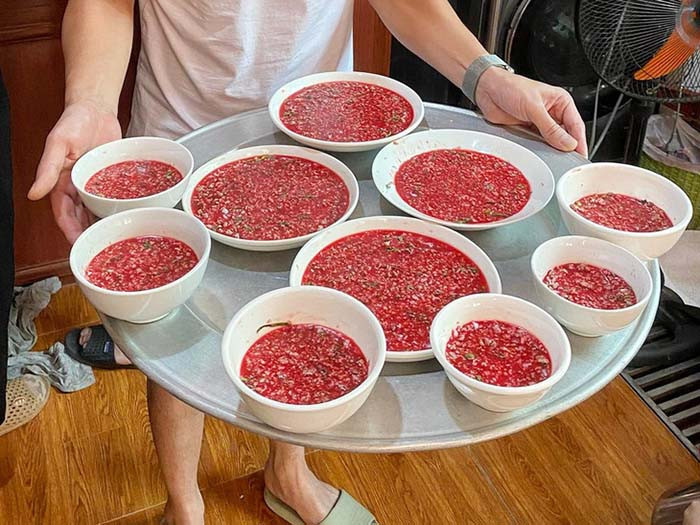On March 14, the Central Hospital for Tropical Diseases announced that it had just treated two patients with critical streptococcal infection after eating blood pudding and slaughtering pigs. Previously, the Hanoi Department of Health also recorded two cases of streptococcal infection.

The Department of Preventive Medicine recommends absolutely not eating pig's blood pudding to prevent the risk of streptococcus suis infection to humans - Illustration: NAM TRAN
Emergency care after pig surgery and eating blood pudding
Specifically, Mr. D.TD (51 years old, residing in Nam Dinh province) after a day of eating pig blood pudding and participating in killing pigs for a wedding, showed signs of fatigue, high fever, chills, and a temperature of 39-40 degrees.
Mr. D. was admitted to Nam Dinh General Hospital with difficulty breathing, rapid breathing, and low blood pressure. Here, the patient was diagnosed with septic shock and cirrhosis.
Mr. D. was given intravenous fluids, maintained on vasopressors, and high doses of antibiotics, but his condition improved little and he was transferred to the Central Hospital for Tropical Diseases.
Here, Mr. D. was diagnosed with sepsis with shock, pneumonia, and blood culture detected Streptococcus suis bacteria (swine streptococcus).
The patient was treated with high-dose intravenous antibiotics, pain relievers, anti-inflammatories, and fever reducers. Currently, after 11 days of treatment, the patient's fever has gone, his shortness of breath has gone, and his infection has improved.
The second case is Ms. D.TC (44 years old, residing in Nam Dinh province) who works as a pig slaughterer. According to her family, Ms. C. was tired and had an unknown fever. Her family found her in a state of agitation, struggling to answer her calls, and then quickly fell into a coma and respiratory failure.
Ms. C. was admitted to Nam Dinh Provincial General Hospital and then transferred to the Central Hospital for Tropical Diseases in a deep coma, with hemorrhagic rash in the palms and soles of both hands and feet, and lung inflammation.
Mrs. C. was diagnosed with sepsis, purulent meningitis, pneumonia, and streptococcal infection. Immediately after, the patient had a lumbar puncture for evaluation, the CSF that came out was cloudy and purulent like rice water.
After 17 days of intensive treatment, Ms. C. has overcome the critical stage, is breathing normally, and has stable hemodynamics.
Previously, Soc Son District Medical Center (Hanoi) also received an emergency case after eating pig intestines and blood pudding.
Specifically, Mr. LQHS (51 years old) was hospitalized with red rash all over his body; chest pain; difficulty breathing. According to Mr. S., about 1 hour before being admitted to the emergency room, he had eaten pig intestines and blood pudding. Mr. S. also said that he had a history of good health and no allergies.
It is recommended not to eat pig's blood pudding.
The Department of Preventive Medicine (Ministry of Health) recommends that to prevent Streptococcus suis infection to humans, people absolutely do not eat uncooked pork products or products from sick or dead pigs, especially do not eat pig blood pudding; take labor protection measures such as wearing gloves and masks for those raising, contacting, slaughtering, and trading livestock.
At the same time, the department also requested units to closely coordinate with veterinary agencies in monitoring and detecting diseases in pig herds that are favorable for swine streptococcus outbreaks such as blue ear disease, promptly sharing information to take measures to prevent the risk of infection to humans; reviewing professional and technical guidelines in monitoring, diagnosing and treating swine streptococcus disease to strengthen the capacity of specialized staff...
According to Tuoi Tre